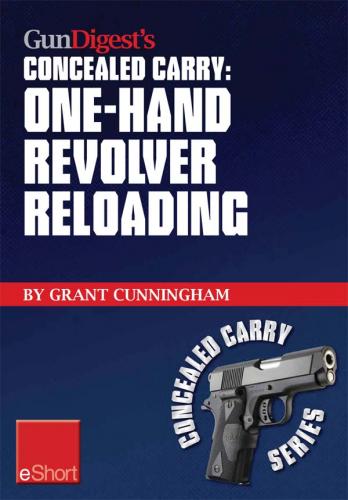Contents
One-Hand Revolver Reloading Concealed Carry
You’ve fired your last shot and recognized that you need to reload your revolver. Finger off the trigger!
A skill that’s often said to be necessary for a defensive handgunner is the ability to reload his or her pistol with only one hand. The rationale is that you might be injured during a fight and not have the full use of both your hands. Given the difficulty of reloading a revolver with two hands, you can see the problem when there’s only one!
Note that I didn’t say that this is a ‘vital’ skill, or absolutely necessary, as the times in which one would be forced to operate their revolver with a single hand during a fight are quite rare. Because of that reality I don’t think you should spend an inordinate amount of time practicing this stuff, but you should do it occasionally just so that you have, in the back of your mind, a grounding of the skill.
The usual rationale for one-hand operation is that you could be injured at the start of an incident and thus have only one hand with which you can shoot and reload. While I think that’s possible – it’s no doubt happened in the course of human history – I don’t believe it’s terribly probable, as it doesn’t seem to occur all that frequently.
People do, however, injure their arms and hands in activities that have nothing to do with self-defense. It is somewhat likely that at some point in your life you’ll injure one hand, or perhaps have a surgical procedure performed, which forces you to contend with doing many skills while injured. This in itself is good justification for occasionally practicing to reload your revolver both right and left hand only.
Right hand only
Bring your thumb up to the hammer spur as you would if you were cocking the gun to single action. (If you’re using a hammerless gun, put it on the back of the frame where a hammer spur would be.) Bring the gun back to your body and rest the butt of the gun somewhere between the top of your belt and the bottom of your sternum. Having the butt contact your body, actually resting there, gives you a solid point around which you can maneuver your hand. This is critical – if the butt of the gun is hanging in free space, it’s a lot harder to do the job!
Notice how the hand can move anywhere on the gun where it may be needed without fumbling. Move your hand up on top of the gun, so that the web of your thumb and forefinger is on the top strap, your thumb is touching the cylinder release, and your fingers are touching the cylinder on the opposite side. You may find that it’s necessary to rotate the gun, using the butt as a pivot point, to make this easier to manage.
Operate the cylinder release with your thumb while simultaneously pushing the cylinder open with your fingers. As the cylinder opens, push your fingers into and through the frame opening.
The gun should now be held by the top strap, with your fingers serving to wedge the cylinder in the open position. Position your thumb on the ejector rod, and lift the gun free of contact with your body.
Push the ejector rod swiftly and fully, one time only. Remember that the chances of a case-under-ejector jam increase greatly with each successive ejection, so resist the urge to pump the ejector rod. A healthy shake of the gun as you do this will help accelerate the casings free of the cylinder.
Rotate the gun so that the muzzle is pointing down, and insert the barrel into your waistband. The cylinder should be on the outside of the waistband.
Let go of the gun and sweep your hand over the top of the cylinder, feeling for any un-ejected cases. If you find any, pluck them out and drop them.
Get your spare ammunition, in whatever form, and insert the rounds into the cylinder.
Twist your hand around so that you can get an approximate firing grip on the gun, and pull it free of the waistband.
Twist the gun clockwise into a natural position, bring the cylinder into contact with your waistband, and rotate the gun counter-clockwise to close and latch the cylinder. (Do not flip the cylinder closed – I don’t care how many times you’ve seen it on TV!) You’re reloaded and ready to go.
Left hand only
After your last shot, bring your finger off the trigger and pull the gun back to contact with your body.
Bring your hand higher on the backstrap of the grip. Your thumb should be pointing in the general direction of the muzzle and contacting the cylinder.
The side of your forefinger should be contacting the cylinder release. As it operates the release latch the thumb pushes the cylinder open.
Once the cylinder is open work your hand forward so that you’re holding the gun by the topstrap, with your thumb under the barrel and contacting the ejector rod.
Push the ejector rod swiftly and fully, one time only. Remember that the chances of a case-under-ejector jam increase greatly with each successive ejection, so resist the urge to pump the ejector rod. A healthy shake of the gun as you do this will help accelerate the casings free of the cylinder.
Invert the gun and push the muzzle down and into your waistband. The cylinder should be on the outside of the waistband.
Sweep your fingers over
